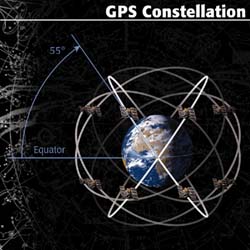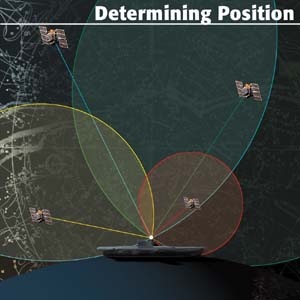| Global
Positioning System satellites transmit signals to equipment
on the ground. GPS receivers passively receive satellite
signals; they do not transmit. GPS receivers require an
unobstructed view of the sky, so they are used only outdoors
and they often do not perform well within forested areas or
near tall buildings. GPS operations depend on a very
accurate time reference, which is provided by atomic clocks
at the U.S. Naval Observatory. Each GPS satellite has atomic
clocks on board.
|
 |
Each GPS satellite
transmits data that indicates its location and the current
time. All GPS satellites synchronize operations so that
these repeating signals are transmitted at the same instant.
The signals, moving at the speed of light, arrive at a GPS
receiver at slightly different times because some satellites
are farther away than others. The distance to the GPS
satellites can be determined by estimating the amount of
time it takes for their signals to reach the receiver. When
the receiver estimates the distance to at least four GPS
satellites, it can calculate its position in three
dimensions. |
| There are at least 24
operational GPS satellites at all times. The satellites,
operated by the U.S. Air Force, orbit with a period of 12
hours. Ground stations are used to precisely track each
satellite's orbit.
|
Determining Position
A GPS receiver "knows" the location of the satellites,
because that information is included in satellite
transmissions. By estimating how far away a satellite is,
the receiver also "knows" it is located somewhere on the
surface of an imaginary sphere centered at the satellite. It
then determines the sizes of several spheres, one for each
satellite. The receiver is located where these spheres
intersect. |
 |
|
GPS Accuracy
The accuracy of a position determined with GPS depends on
the type of receiver. Most hand-held GPS units have about
10-20 meter accuracy. Other types of receivers use a method
called Differential GPS (DGPS) to obtain much higher
accuracy. DGPS requires an additional receiver fixed at a
known location nearby. Observations made by the stationary
receiver are used to correct positions recorded by the
roving units, producing an accuracy greater than 1 meter.
When the system was created, timing
errors were inserted into GPS transmissions to limit the
accuracy of non-military GPS receivers to about 100 meters.
This part of GPS operations, called Selective Availability,
was eliminated in May 2000.
|